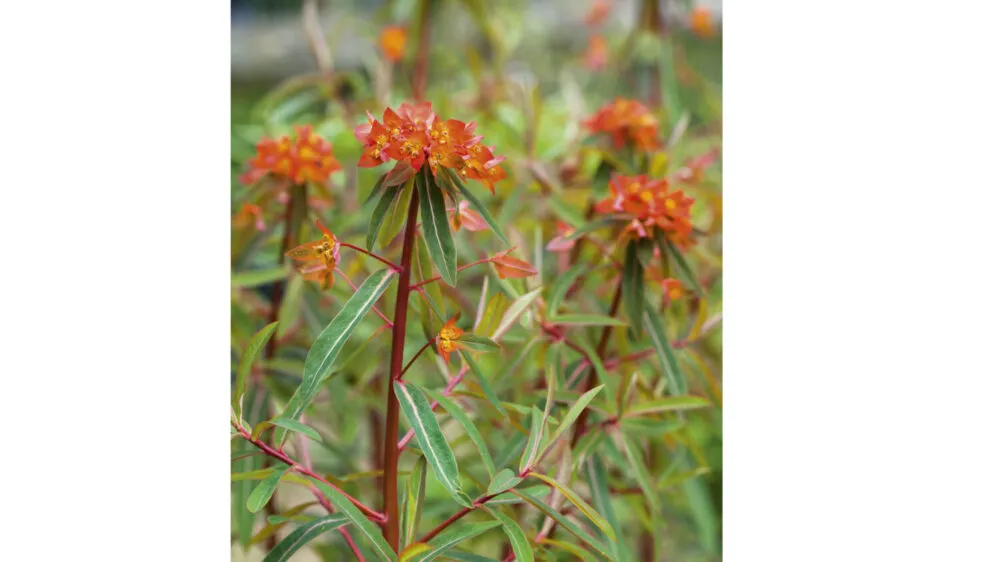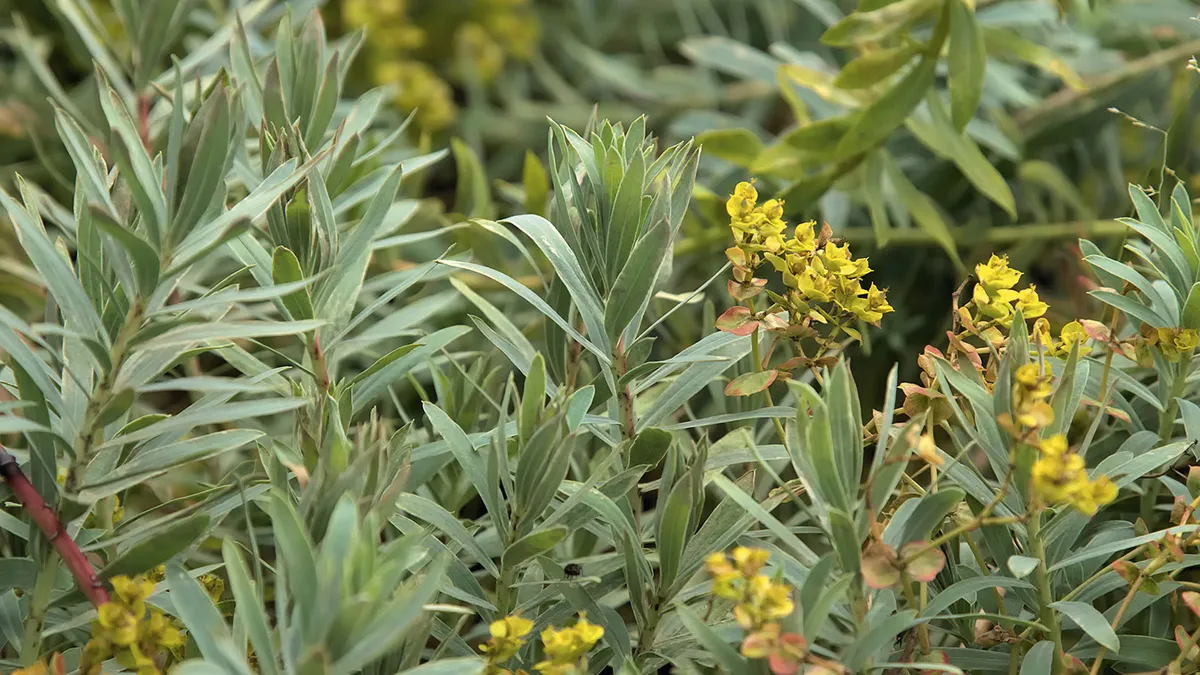Euphorbias are striking plants, ranging from small, low-growing annuals to large, structural shrubs and succulents. They are extremely useful garden plants, and there is a euphorbia for almost every situation. They are grown for their spring interest in the form of their new growth, stems and flowers, for their evergreen architectural value and for their surreal, ‘other worldly’ appearance.
Euphorbias' natural habitats range from Macaronesia to the Himalayas. They vary in size from stiffly upright to prostrate and spreading, with a height of between 10cm to 2.5m and a similar spread.
PLANT PROFILE
What Annuals, perennials, shrubs or succulents. Origins Their natural habitats range from Macaronesia to the Himalayas. Season Early spring to autumn. Size Variable, from stiffly upright to prostrate and spreading, with a height of between 10cm to 2.5m and a similar spread. Conditions Some prefer free-draining soil in hot sunshine while others flourish in moist or dry shade. Hardiness RHS H3 to RHS H7, and from USDA 6a to 11.
Euphorbias work well in many different planting schemes. Those preferring hot, dry conditions grow well in gravel gardens among lavenders, salvias, cistus and Mediterranean bulbs, such as alliums and nerines.
E. amygdaloides ‘Purpurea’ creates a wonderful contrast with the ornamental grass, Milium effusum ‘Aureum’ while the bold architectural domes of E. x pasteurii ‘John Phillips’ and E. mellifera are perfect specimen plants in an exotic border where their foliage combines well with cannas, hedychiums and dahlias.
Shade-loving euphorbias look great planted with other woodland or shade loving plants, such as dicentra (Lamprocapnos), erythroniums and corydalis.
Where to grow euphorbia
Euphorbias can be found growing in a range of habitats, from Mediterranean scrub to cool temperate woodland, in acidic or alkaline soil. Some therefore prefer free-draining soil in hot sunshine while others flourish in moist or dry shade. Depending on the species, their hardiness varies from RHS H3 to RHS H7, and from USDA 6a to 11.
How to prune euphorbia
Once the bracts of Euphorbia x pasteurii, E. amygdaloides, E. mellifera and E. Blackbird (= ‘Nothowlee’) have turned brown, cut off the dead growth to the first ring of leaves below.
E. x martini and E. myrsinites have two types of stems; those from the previous season on which the flowers appeared, and the new season’s growth. Cut out the stems that flowered the previous year down to ground level in late summer or autumn.
Herbaceous perennials, such as E. cyparissias, E. griffithiiand E. sikkimensis, should be deadheaded after flowering then cut back to ground level before the first frosts.
How to propagate euphorbia
You can propagate euphorbias by taking basal cuttings from young, non-flowering shoots in mid-spring, but wear protection while doing so, as the sap can irritate skin and eyes. Select and remove material early in the morning and put it in a polythene bag straightaway to prevent it drying out.
- Take cuttings 7-10cm long, making a cut at the base with a sharp knife.
- Remove the lower leaves, dip the cut in ground charcoal to seal the wound.
- Knock off the excess, make a hole with a dibber or pencil into a pot of 50:50 mix of sieved peat-free compost and perlite or cutting compost, and water.
- Put the pot in a propagator with bottom heat of 18-24oC in bright but not scorching sunlight.
- Keep the compost moist, removing dead, diseased or dying material daily. Rooting takes up to a month.
After rooting, harden off the cuttings and re-pot them into individual pots before transplanting outdoors. Many species self-seed in gravel borders or cracks in paving (cultivars must be propagated vegetatively as they do not come true from seed). They can also be divided in early spring, using a sharp knife, though the woody roots can make this challenging.
The best euphorbias for your garden
The euphorbias featured in this profile flower in late spring to early summer.
1

A refined, dome-shaped evergreen with narrow, bright green leaves that have a pale mid-vein. Grow in well-drained, light soil in full sun or in a container and overwinter frost free, indoors. The leaves hang limp in frosty weather but perk up when the temperatures rise. 2.5m. AGM*. RHS H3.
2
‘Dixter’

This spreading deciduous plant forms an unconventional splash of narrow dark-green leaves that are tinged with red. The orange-red flowers contrast well with dark-purple tulips such as Tulipa ‘Queen of Night’. It prefers moist, humus-rich soil but tolerates drier conditions. 1m. RHS H7, USDA 5a-9b.
3
Euphorbia Blackbird (= ‘Nothowlee’)

The narrow, green leaves of this dwarf evergreen are flushed with dark reddish purple, and its bi-coloured yellowish green flowers appear from early spring. Grows happily in containers and in well-drained, light soil in full sun. 50cm. RHS H5, USDA 6a-9b.
4
Euphorbia characias ‘Black Pearl’

A clump-forming cultivar that is much loved by pollinating insects. Its lime-green flowers have purple nectar-filled ‘eyes’. An ideal euphorbia to grow in containers or borders in well-drained, light soil in full sun. 1m. RHS H4, USDA 6a-8b.
5

Forms a clump of erect shoots, that emerge shocking, glassy red in spring; the white-veined leaves later cooling to soft green. Ideal in damp, humus-rich soil in light dappled shade, it makes a marvellous feature plant to surprise visitors. 1.5m. AGM. RHS H5.
6
‘Fens Ruby’

This fabulous deciduous plant creates a carpet of fine, purple leaves and stems topped by greenish- yellow flowers from late spring. Ideal for gravel gardens, it is also excellent in coastal gardens and good for pollinators. 50cm. RHS H7.
7
Euphorbia x pasteurii ‘John Phillips’

An evergreen shrub with yellow-green foliage and a pale midrib. The fragrant, yellow-green flowers, produced from late spring over a long season, are followed by yellow-green fruit. An excellent drought-tolerant plant. 1.5m. AGM. RHS H4.
8
Euphorbia myrsinites

An architectural mat-forming species with stems to 35cm and flower clusters to 10cm wide. Introduced into Britain from southern Europe, it flourishes in well-drained soil in full sun and is ideal for a Mediterranean garden. 50cm. AGM. RHS H5, USDA 5a-9b.
9
Euphorbia amygdaloides ‘Purpurea’

An undemanding plant with deep purple stems and leaves and contrasting lime-green flowers. It is shallow rooted so easy to control if it spreads. Very versatile, it can be used in moist or dry shade, on banks or for groundcover. 1m. RHS H6.
10
Euphorbia x martini ‘Ascot Rainbow’’

Leaves emerge grey-green with a pinkish-red flush and later develop a creamy- yellow margin, which can take on a pink flush during cold weather. The flowerheads are also variegated and it is drought tolerant once established. 1.5m. AGM. RHS H5.
11
Euphorbia ‘Whistleberry Garnet’

A compact evergreen that’s ideal for containers. Red-flushed leaves and stems are topped with distinctive yellow-green flowers with a bright red eye. Grow in well-drained, light soil in full sun. Spreading but easy to control. 70cm. AGM. RHS H7.
12
Euphorbia ‘Blue Haze’

Forms a compact, mound of slender stems clothed with intense blue-grey, lance-shaped leaves.
The tiny, yellow flowers, surrounded by yellow- green bracts, appear from spring to midsummer. A highly desirable plant for hot, sunny borders. 50cm. RHS H5, USDA 6a-10b.
Where to buy and see euphorbias
- Burncoose Nurseries Gwennap, Redruth, Cornwall TR16 6BJ. Tel 01209 860011, burncoose.co.uk
- Claire Austin Hardy Plants White Hopton Farm, Wern Lane, Sarn, Newtown, Powys SY16 4EN. Tel 01686 670342, claireaustin-hardy plants.co.uk
- Crûg Farm Plants, Griffith’s Crossing, Caernarfon, Gwynedd LL55 1TU. Tel 01248 670232, crug-farm.co.uk
- Don Witton* 26 Casson Drive, Harthill, Sheffield, South Yorkshire S26 7WA. Tel 01909 771366. Open by appointment only.
- Larch Cottage Nurseries, Melkinthorpe, Penrith, Cumbria CA10 2DR. Tel 01931 712404, larchcottage.co.uk
- University of Oxford Botanic Garden & Arboretum*, Rose Lane, Oxford OX1 4AZ. Tel 01865 610300, botanic-garden.ox.ac.uk
* Author Matthew Biggs is a broadcaster and garden writer.
*National Collection holders

